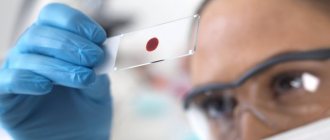Dozens of blood substances have the ability to quickly enter complex reactions with the release of a minimum of heat and energy. Therefore, a person normally does not feel transformations.
Hemoglobin is one of the most important compounds found in the blood. The structure is part of red blood cells, the so-called erythrocytes.
It performs two functions:
- Carries oxygen to tissues. Provides cellular gas exchange.
- Transports carbon dioxide in the opposite direction.
There are several modifications. The so-called glycated hemoglobin is the same substance only associated with sugars; normally it ensures the transport of glucose, its processing and metabolism.
The formation of the named modification of the compound occurs in several complex stages. The biochemical reaction ends with the formation of three main fractions (types) of glycosylated hemoglobin:
- First. Does not have much clinical significance.
- Second. The same.
- Third. This is what is mainly being studied, since the substance clearly and accurately shows diabetes and other pathological processes. Those associated with the metabolism of sugars in the body.
The substance is otherwise designated as HbA1C. It is this indicator that can be found on the blood test form. Less commonly used names are hemoglobin Ale and HbAl.
The role of the compound in the body
The substances in question perform one key function, although sometimes they speak of two.
- Binding of sugars. This refers to excess glucose. Analyzes show this process well. It is especially noticeable in diabetics. Persons suffering from impaired synthesis and processing of poly- and monosaccharides. Simply put, this is not a transfer, but rather an inactivation of sugars. It happens all the time. Without interruptions throughout a person's life.
- Transport of glucose to tissues. As is the case with typical Hb, the sugar-containing form ensures the transfer of energetically valuable substances to tissues and individual cells. Hence the high rate of energy metabolism. For this reason, glycosylated hemoglobin is one of the key compounds in metabolism.
Such hemoglobin also plays a less noticeable role: we are talking about the most important laboratory practice - testing blood for sugar.
As a rule, the study of Hb1Ac concentration is carried out in parallel to obtain more accurate and informative results. This is an absolutely correct examination tactic.
When is the test ordered?
There are quite a lot of indications for diagnosis. Each of the reasons requires additional examination. Because a blood test alone will not be enough to make a diagnosis.
- Constant thirst. Moreover, it is equally strong at any time of the day. The process is accompanied by an unbearable desire to consume water, but even after a glass, or even several, it does not become easier.
- Increased urine production. Urine is synthesized in huge quantities - up to five liters per day. This is the so-called polyuria. A typical symptom of diabetes. The reason is a disorder of the kidneys.
- Blood clotting disorder. It is enough to pick off a small scab after a minor injury (for example, a cut) for severe bleeding to begin. These symptoms are especially noticeable after surgery. For example, tooth extraction or something more serious.
- Problems with wound healing. Even minor damage requires careful care. This is especially common in diabetes mellitus. At advanced stages of the pathological process, a small scratch or callus can provoke gangrene.
- Sudden changes in body weight. Either an increase or a decrease. And within wide limits. We are talking about tens of kilograms in a matter of weeks. This is not normal and indicates pathologies of the endocrine profile.
- Problems with the central nervous system. Headaches, nausea, vomiting.
- Impaired cognitive and mental abilities. Decreased intellectual potential.
And others. Simply put, the main indication for a blood test for glycated hemoglobin is suspicion of diabetes mellitus, especially if the symptoms support the diagnosis.
The same applies to differential diagnosis. A good half of the described underlying symptoms are accompanied by diabetes insipidus and damage to the central nervous system, when the pituitary gland and hypothalamus secrete an insufficient amount of the antidiuretic hormone vasopressin. It inhibits urine synthesis.
The question of diagnosis falls on a specialized specialist - an endocrinologist. If necessary, outside doctors are also involved. For example, a hematologist.
How to get tested for glycated hemoglobin
You can donate blood to determine glycated hemoglobin in your clinic as prescribed by a doctor, and if you don’t have this indicator, then it will definitely be done in any paid laboratory, and a referral is not needed. Usually all laboratories ask you to come for a blood draw on an empty stomach; this rule is necessary to avoid problems with the blood, since the composition of blood after a meal is somewhat different from blood on an empty stomach. In general, for glycated hemoglobin, it makes no difference whether you test on an empty stomach or after a meal, because the indicator reflects the glucose level over the last 3 months, and not at a specific point in time. But I still recommend taking the test on an empty stomach, this is how you can avoid wasting time and money on a retake in the event of an unsuccessful analysis, which may very well fail due to violation of a banal rule. No special preparation is required for blood collection.
How many days does it take to prepare an analysis for glycated hemoglobin?
Typically, a glycated hemoglobin test is done within 3-4 days, so you don’t have to wait long to find out your result.
Where is blood taken for glycated hemoglobin?
As a rule, blood is taken from a vein, but there are methods for taking material for glycated hemoglobin from a finger.
How to rent
The analysis is carried out using standard methods:
- The subject arrives at a certain time. Definitely on an empty stomach. Because after eating, the likelihood of a glucose spike increases. The results will be false.
It is important that the patient does not eat anything for at least 8 hours. Plus you need to give up smoking, drinking alcohol, intense physical activity, overheating and hypothermia. All these are factors of a false result.
- On site, in the laboratory, the patient donates blood from a vein.
- The doctor numbers and labels the tube and sends it directly to the laboratory for testing.
The result comes after 1-2 days. It is handed out or sent to the doctor who ordered the study.
From the point of view of the subject, there is no difference compared to general blood biochemistry. Diagnosis is carried out in exactly the same way.
How to prepare for the test
Let's talk about how to donate blood and where this procedure can be performed. The collection of biomaterial does not depend on the time of day, on whether food was taken before or not - the results obtained will not undergo global changes - it is advisable to adhere to some restrictions:
- It is better not to eat five hours before the procedure and still carry it out on an empty stomach, refuse to drink soda and tea.
- Considering that blood is taken from a vein in quite a large amount, some patients may experience dizziness and slight nausea - accordingly, the preparation stages include purchasing ammonia at the pharmacy or warning the laboratory assistant about possible problems.
- It should be taken into account that stressful situations can have a negative impact on the result, and significant blood loss, labor, and heavy periods can also distort the data.
As you can see, there are no difficulties in taking the test correctly - the usual loads and the use of a standard diet are allowed. The blood test is carried out for approximately 75 hours; this parameter, together with the cost, depends on where the donation takes place and what the technical equipment of the laboratory is.
Now about where to submit biomaterial for research. The best option both in terms of speed and reliability would be a private clinic - it takes into account the client’s comfort, the attitude of the staff and their qualifications, the condition of the equipment and the very quality of the procedure.
What diagnoses can be made
According to the results of the study, glycated hemoglobin shows two main diagnoses:
- Impaired sugar processing. If the concentration of the substance increases, it is almost 100% likely that we can talk about diabetes.
- In some cases, pathological changes accompany disorders of the thyroid gland. When too few substances are produced and they are not able to suppress the excess absorption of sugars.
In some cases, high levels are considered a variant of the clinical norm. But to confirm this, you need to conduct a comprehensive diagnosis under the supervision of an endocrinologist.
If there are no indicators of diabetes or other symptoms of the disease, dynamic monitoring of the patient’s condition is continued and additional measures are prescribed.
Tables of norms by age
Among women
The norm of glycated hemoglobin in women is approximately a quarter higher than in men, and the maximum values increase with age by almost three times. Detailed data is presented in the table:
| Age (years) | Norm in percent |
| 15-20 | 3-4% |
| 20-30 | 4-7% |
| 30-50 | 5-7% |
| After 50 | 7-9% |
In men
Glycated hemoglobin in men normally does not increase so much with age, as can be seen from the table:
| Years | Glycated hemoglobin level (%) |
| 15-20 | 4.3-5.6% |
| 20-30 | 5-6.5% |
| 30-50 | 5-6.5% |
| 50 and older | About 7% |
In children
In children, the normal Hb1AC ranges from 4 to 5.5 percent.
In diabetics
The concentration of the substance is about 8%. This is an adequate value, since the body gradually gets used to the new, changed state.
Correspondence table between HbAl and glucose levels
Hemoglobin and sugars are closely related. Glycated fractions are formed through the Maillard reaction. When proteins and saccharides interact.
As a rule, when diagnosing diabetes and a number of other pathological processes, both hemoglobin concentration and glucose levels are examined. Both indicators complement each other. This method is much more informative.
If we talk about compliance with norms and correlation:
| HbA1c level in percent | Sugar concentration in mmol/liter |
| 4 | 3.8 |
| 5 | 5.4 |
| 6 | 7 |
| 7 | 8.6 |
| 8 | 10 |
| 9 | 11.5 |
| 10 | 13.5 |
| 11 | 14.3 |
| 12 | 16 |
| 13 | 18 |
| 14 | 20 |
| 15 | 21 |
| 16 | 23 |
| 17 | 25 |
| 18 | 26 |
| 19 | 27.7 |
The figures are approximate. Deviations of both values are possible.
Pathological reasons for the increase
An increase in glycated hemoglobin in the analysis does not bode well for the patient: with one hundred percent probability we can talk about damage to the body. If we make allowances for natural changes, it is worth mentioning the figure 95-97%.
Here is just a small list of pathological processes.
Spleen lesions
This organ is responsible for the deposition (accumulation) of blood cells. In particular, red blood cells. This is where red blood cells end their lives, die and are recycled. However, this is not all. The cycle continues constantly.
With lesions of the spleen, an increase in glycated hemoglobin occurs. Because the organ is no longer able to function normally and absorb waste material. Old cells remain in the blood - hence the increase in the concentration of the substance.
Treatment depends on the essence of the pathological process. Most often, disorders of the spleen are eliminated radically. The organ is removed. After some time, the body itself will adapt to the new conditions and everything will be fine.
Liver disorders
The organ plays a key role in all biochemical processes without exception. Diseases such as hepatitis or cirrhosis have an effect.
- In the first case, an inflammatory process occurs without tissue destruction or death. At least fatal dysfunctions do not occur immediately.
- The second pathological process is necrosis itself, the death of liver tissue. If you don't help the largest gland, the consequences will be fatal.
Treatment. Hepatoprotectors are prescribed. Essentiale, Karsil. Herbal infusions are possible. But only as an auxiliary method.
For liver cirrhosis, medications are needed, and an organ transplant is also prescribed. With the help of pills you can suppress and slow down the course of the disorder. Take the disease at least partially under control.
Iron deficiency
Causes iron deficiency anemia. Accordingly, in order to correct the pathological process, special treatment is required.
First-line drugs are ferrocontaining solutions. They artificially replenish iron concentrations. They return everything to normal. Accordingly, glycated hemoglobin is restored.
However, not all so simple. Pathologies sometimes affect the digestive tract. The gastrointestinal tract cannot absorb iron normally. In this situation, all that remains is to treat the underlying disease.
Afterwards, we can talk about the concentration of the substance returning to normal.
Diabetes
A classic endocrinological disorder. Accompanied by impaired insulin production or tissue insensitivity to this substance.
In both cases, the consequences are severe: damage to the central nervous system, digestive tract, and circulatory structures. Everything suffers. Diabetes mellitus is the main reason for which the concentration of glycated hemoglobin in the blood increases.
Treatment consists of symptomatic correction of the body's condition.
- It is necessary to administer insulin systematically, as needed. This is necessary to adjust your sugar levels.
- Patients must adhere to a gentle fortified diet. Minimum fat, easily digestible carbohydrates.
- It is necessary to adjust your body weight. Otherwise there will be no point in therapy.
Glycated hemoglobin returns to normal on its own as soon as the amount of sugar is restored.
Advantages and disadvantages of the analysis performed
The main advantages of this analysis, in comparison with studies on blood sugar levels, as well as with two-hour testing for glucose tolerance, are:
- the impossibility of deliberate distortion of its indicators;
- the speed and accuracy of this study is higher than that of similar ones;
- allows you to detect the presence of diabetes mellitus at the initial stage, when other tests “speak” about the absence of this disease;
- the method of taking blood for testing requires maintaining preanalytical stability (physiological fluid is stored in a test tube until the test is carried out);
- You can donate blood for analysis not only on a full stomach, but also regardless of the time of day;
- allows you to control the quality of recommendations carried out by a diabetic that help reduce sugar;
- the final HbA1C values are not affected by the presence of colds, stress, physical activity, or medications taken (with the exception of medications for the treatment of diabetes);
- universality of the study for all age groups.
Due to the lability of blood sugar, determining its quantitative value using this study is the most complete and reliable, allowing one to detect disorders of glucose metabolism in the early stages. But, at the same time, the analysis for glycosylated hemoglobin has a number of disadvantages:
- the cost of this analysis, in comparison with similar ones, is much higher;
- low regional accessibility of institutions conducting such research;
- if the patient has anemia or hemoglobinopathy, the test result may be unreliable;
- distortion (underestimation) of the final result of the analysis when the patient consumes vitamins C and E in increased dosages;
- the study does not take into account the reduced correlation between the average glucose level and HbA1C, which is characteristic of certain categories of people;
- the result of the analysis may be overestimated if a person has low levels of thyroid hormones.
For early detection of diabetes mellitus and monitoring the quality of drug therapy for the disease, each patient should know what glycosylated hemoglobin is, how to test it correctly, what is the norm for this indicator, and also try to maintain it at an optimal level. This will not only reduce the risk of complications (if the disease is present), but also prevent (if you follow a low-carbohydrate diet) the development of diabetes.
Natural factors
There are also reasons that you can influence on your own. Or there is no need to change anything at all.
- For example, in infants the concentration of glycated hemoglobin is significantly higher than in adult patients. Sometimes the levels go completely off the charts. Is this pathology? No, we are talking about a variant of the physiological norm.
- In pregnant women, concentrations increase gradually until they reach a peak. The reaction occurs quickly, glycated hemoglobin enters the fetal bloodstream through the placenta. Hence the increase in indicators.
This is the so-called fetal variant of the connection. It leaves the body within a few weeks. Maximum of a month after birth. This is the product of a foreign organism, in the described case - the maternal organism. If the concentration is consistently high, there is every reason for diagnosis by an endocrinologist.
- Changes also apply to poor nutrition. For example, with high sugar levels.
- After all, laboratory errors are also possible. True, insignificant.
- There is also such a reason for an increase in glycated hemoglobin as improper preparation. The results, for example, after eating, will be significantly higher than normal. Therefore, the examination is carried out on an empty stomach.
- Glycated hemoglobin increases in pregnant women. This does not always happen. As a rule, growth indicates the active formation of the fetus. Sometimes it is possible to develop twins.
But the same thing can be an alarming first call. For example, when developing diabetes mellitus in a pregnant woman. For this reason, persons prone to the disease should consult an endocrinologist even at the planning stage of gestation.
Treatment is prescribed according to need. If the doctor thinks it is necessary. Pregnant women undergo blood tests several times a month.
An increased level of glycated hemoglobin means that there is a disease of the gastrointestinal tract, blood or endocrine system. There are several options. The doctor’s task is to understand the situation.
How and with what to reduce glycated hemoglobin
A decrease in glycated hemoglobin is inextricably linked with a decrease in blood glucose levels. Therefore, in order to reduce HbA1c levels, it is necessary to follow all the doctor’s recommendations for the treatment of diabetes, namely:
- Follow a special type of diet and regimen.
- Be active in physical education.
- Take medications or insulin on time.
- Maintain a sleep-wake schedule.
- Monitor your glucose levels at home more often.
- Arrive on time for your appointment.
If you see that from all your efforts, your glucose level is normalized during the day and you feel better, then you are on the right track and the next blood test will please you well.
Reasons for the decline
Insufficient levels of glycated hemoglobin are less common. Most often, the following disorders are to blame.
- Massive bleeding. Especially if the patient has lost a lot of connective tissue. In such a case, the reason is standard. Physically, there is less blood. Consequently, the concentration of both simple and glycosylated hemoglobin decreases. The number of formed cells also decreases.
The Hb1Ac level is restored on its own after treatment. It is important to eliminate the underlying factor. For example, introduce red blood cells, liquid fraction of blood (plasma), etc.
- Performed blood transfusion. Especially if only the rheologically fluid part of the connective tissue is used. The reason is again purely physical. The concentration of glycated hemoglobin is lower because the blood is diluted. Then, after some time, everything returns to normal by itself.
- If there is a violation, if the amount of glycated hemoglobin does not increase, red blood cells are infused. In this case, a temporary increase is possible, which is quite acceptable and can happen.
- Insufficient supply of glucose to the blood. As a rule, it is caused by eating disorders. Usually diets, but not always. The same is possible with insufficient absorption of sugars. Pathology of the digestive tract is considered to be to blame. What exactly it is - doctors will have to figure it out.
- Other variants of hypoglycemia. For example, against the background of insufficient functional activity of the thyroid gland. In the body, especially the endocrine system, everything is closely connected. A decrease in concentration has a detrimental effect on the body's condition. All systems suffer.
Sometimes there are variants of the physiological norm. For example, during pregnancy, sugar and glycated hemoglobin can both rise and fall. Moreover, in the same patient, the phases change in a matter of days.
This is normal and does not require special treatment. Unless you need to be systematically checked by a doctor if such “swings” are present.
The consistency of glycated hemoglobin and sugar levels in pregnant women is checked once a week or more often. At the discretion of the attending physician. The patient is recommended to purchase a glucometer.
Causes of low glycated hemoglobin in the blood
When this indicator decreases below 4%, persistently low blood glucose levels are observed, which may, but does not necessarily, manifest as symptoms of hypoglycemia. The most common cause of this may be insulinoma, a tumor of the pancreas that produces large amounts of insulin. At the same time, a person does not have insulin resistance and with high insulin levels, sugar is well reduced, causing hypoglycemia. In addition to insulinoma, low sugar levels, which will lead to glycated hemoglobin less than normal, can cause the following conditions and diseases:
- overdose of glucose-lowering drugs (tablets and insulin)
- long-term low-carb diet
- long-term intense physical activity
- adrenal insufficiency
- rare genetic diseases (Hers disease, von Gierke disease, Forbes disease, hereditary fructose intolerance)
Additional examinations
There are quite a few auxiliary techniques.
- Oral interview and history taking. Doctors record complaints and also examine the probable origin of the deviation in laboratory analysis. This is the first and very important step. Since it sets the vector for all further diagnostics.
- Measuring sugar levels. Building a graph. Specialized technique. It is actively used to examine patients with diabetes. Or as a screening method for healthy people. Who have not yet received a serious diagnosis.
- Ultrasound of the digestive tract.
- FGDS is prescribed as needed. Endoscopy provides information about the organic state of the gastrointestinal tract.
The study of the level of glycated (glycosylated) hemoglobin is mainly used to diagnose diabetes, as well as to assess the quality of therapy and the dynamics of the pathological process. That is, how it develops over time. This is a screening technique.
General information about the analysis
So, let's figure out what it is - an analysis for glycated hemoglobin.
This test helps estimate the average blood glucose levels over the past few months.
Hemoglobin is an oxygen-carrying protein found inside red blood cells. There are several types of normal hemoglobin, in addition, many abnormal varieties have been identified, although the predominant form is considered to be hemoglobin A, accounting for ninety-five percent of total hemoglobin. Hemoglobin A is divided into several components, one of which is A1c.
Some circulating glucose may spontaneously bind to hemoglobin, forming glycated hemoglobin. The higher the concentration of glucose in the blood, the more intensely it is formed. Combining with hemoglobin, glucose remains with it as if in one bundle until the very end of the erythrocyte’s life, that is, for one hundred and twenty days. The glucose compound with hemoglobin A is called A1c in medicine. Glycated hemoglobin forms in the blood and disappears from it every day. Old red blood cells quickly die, and young ones (which are not yet glycated) take their place.
The hemoglobin A1c test is used to monitor the condition of patients diagnosed with diabetes mellitus. It helps assess how effectively glucose levels are regulated during therapy.
It is important to find out in advance how to get tested for glycated hemoglobin, on an empty stomach or not. Its reliability depends on this.
For some patients, a test to determine this type of hemoglobin is prescribed to diagnose diabetes, and also pre-diabetes, in addition to a fasting blood plasma glucose test. Additionally, a glucose tolerance test may also be performed.
The resulting indicator is measured as a percentage. Patients who suffer from diabetes need to strive to maintain its level; it is important that it does not exceed seven percent.
Therefore, you need to know how to correctly take a test for glycated hemoglobin.
Hemoglobin A1c must be reported in one of the following ways:
- As a percentage of the total amount of hemoglobin.
- The unit of measurement is mmol.
- As the average glucose content, mmol/l.
Now we will find out for what purposes this laboratory research is being carried out.
Many people do not understand how to take a test for glycated hemoglobin - from a vein or from a finger. We'll talk about this below.









